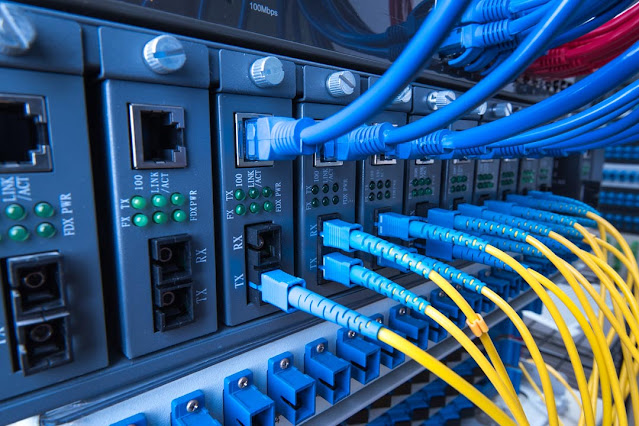 |
| Data Center Switch |
As digital transformation continues reshaping businesses across all industries, reliable and high-performing data centers have become more important than ever. Serving as the backbone of modern IT infrastructure, data centers house servers, storage, networking equipment and other essential hardware. Advanced data center switches play a pivotal role in optimizing data transfer and connectivity within these core facilities.
What are Data Center Switches?
A data center switch is a high-performance networking device installed in a data center to connect servers, storage systems and other networked devices. These switches operate at higher speeds and provide greater port densities than typical enterprise switches used outside the data center. Various form factors are available depending on space constraints and throughput needs, including top-of-rack, end-of-row and core switches.
Data Center Switch deliver ultra-low latency and non-blocking throughput to optimize application performance and virtualization. Advanced switching silicon and deep buffers enable seamless Layer 2 and 3 connectivity between thousands of endpoints. Modern designs also integrate critical data center networking capabilities like virtual switching, automation, visibility and analytics. Reliability is paramount as well, with redundant power supplies, fans and components ensuring continuous uptime.
Routing High-Traffic Workloads
The primary function of data center switches is directing traffic between networked devices within the physical infrastructure. As more enterprises rely heavily on virtualization and cloud-native architectures, workloads have become more distributed than ever. Data center switches establish high-speed connections between physical and virtual servers running mission-critical applications and databases.
Top-of-rack and end-of-row switches aggregate traffic locally before forwarding it upstream or downstream. Core switches residing at the highest layer then route traffic laterally across logical tiers and between geographically dispersed data centers. This three-tier hierarchical model maximizes bandwidth utilization while maintaining predictable performance. Large memory buffers also prevent any packet loss that could disrupt service quality or availability.
Implementing Virtual Environments
Virtualization has revolutionized computing by allowing workloads to be abstracted as software separate from physical hardware resources. However, this flexibility introduces additional networking complexities that challenge traditional switch designs. Data center switches address these challenges with virtual switching capabilities that intelligently route traffic between physical and virtual devices.
For example, virtual switches running on top-of-rack devices can intelligently distribute traffic from physical servers running hypervisors to virtual machines spawned on demand. This "east-west" traffic between VMs is encapsulated and switched similar to north-south traffic entering and leaving the data center from end users. Advanced visibility tools integrated with the switches also provide complete application and network visibility for troubleshooting virtual environments.
Empowering Modern Architectures
Containerization and microservices-based architectures similarly benefit from intelligent data center switching designs. Containers allow developers to deploy applications as lightweight software packages, yet for containers to operate seamlessly at scale requires deep integration between the container orchestration platform and underlying physical networking.
Data center switches expose consistent network semantics and security policies to container workloads regardless of where they are physically deployed. For container networks spanning hybrid cloud environments, distributed switches implement overlay networking techniques like VXLAN to transparently interconnect infrastructure segments. Advanced monitoring and telemetry also help pinpoint performance bottlenecks.
Driving Operational Efficiencies
As enterprises embrace digital transformation initiatives, data center operations face mounting pressure to optimize costs while maintaining service quality expectations. Data center switches address these requirements through integrated automation and analytics capabilities.
Advanced switch software enables one-click provisioning of ports, end-to-end provisioning workflows and change management integrations. Built-in telemetry continually monitors network utilization, congestion, latency and errors to identify underlaying issues before performance is impacted. Global analytics and machine learning identify anomalies and inefficiencies, empowering optimizations that lower power consumption and carbon footprint. Pre- and post-deployment validation testing ensures settings adjustments avoid disruptions.
Securing Infrastructure Access
Naturally, data center security is also critical given the sensitive data and assets housed within. Data center switches strengthen access controls and compartmentalize infrastructure using techniques like port security, MAC address filtering, VLAN segmentation and ACL policies.
Advanced encryption protocols maintain data confidentiality and integrity in transit using IPSec VPNs or encryption at lower OSI layers. Tight change auditing integrates with existing identity systems to only permit approved configuration changes by validated administrators. Network microsegmentation limits lateral spread of threats by isolating workloads with granular subnets and security groups.
As the core networking technology behind modern data centers, high-performance switches play an indispensable role in service delivery. Advanced designs deliver ultra-low latency, massive non-blocking throughput, operational simplicity, visibility and security controls required in digital era. When combined with virtualization, containerization and other cutting-edge architectures, next-generation data center switches optimize infrastructure to maximize ROI from digital transformation initiatives.
Get More Insights On This Topic: Data
Center Switch
Explore More Related Topic: Coronary
Stents
